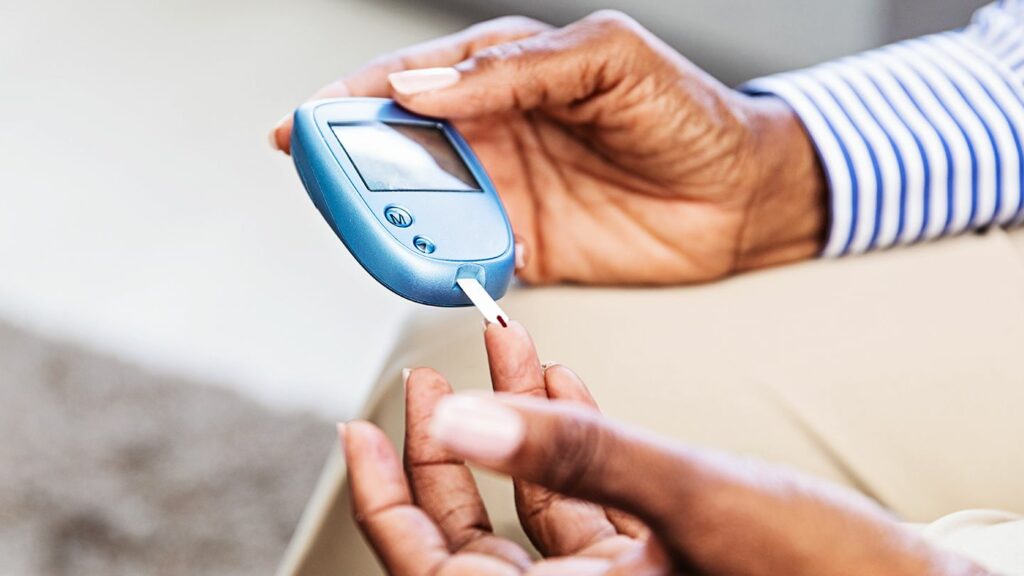Blood glucose, commonly referred to as blood sugar, is a crucial indicator of our overall well-being, influencing everything from energy levels to long-term health risks. Understanding the symptoms associated with abnormal glucose levels is essential for early detection and management of potential health issues. This blog aims to enlighten readers about the signs and symptoms of glucose levels, providing insights into the body’s response to these conditions and offering guidance for maintaining optimal health.
Contents
What Are The Symptoms Of Glucose Levels?
 Blood glucose levels, whether high or low, can exhibit a range of symptoms. It’s important to recognize these symptoms as they play a crucial role in the management of conditions like diabetes. Here’s a breakdown of the symptoms of glucose levels:
Blood glucose levels, whether high or low, can exhibit a range of symptoms. It’s important to recognize these symptoms as they play a crucial role in the management of conditions like diabetes. Here’s a breakdown of the symptoms of glucose levels:
Symptoms of High Blood Glucose (Hyperglycemia)
- Increased Thirst and Urination: When blood sugar levels are high, the kidneys try to remove excess sugar by filtering it out of the blood. This leads to increased urine production, which can cause dehydration and a consequent increase in thirst. This cycle of frequent urination and increased thirst is one of the earliest and most common signs of hyperglycemia.
- Fatigue: High blood sugar levels can cause fatigue for several reasons. First, when insulin is insufficient or ineffective, glucose cannot enter the cells efficiently for energy, leading to a feeling of being tired and lethargic. Additionally, frequent nighttime urination can interrupt sleep, contributing to tiredness during the day.
- Blurred Vision: Hyperglycemia can affect the shape of the lens in the eye, either through fluid level changes or swelling, leading to temporary changes in vision, including blurriness. These vision issues can fluctuate with changing blood sugar levels.
- Headaches: Fluctuating or high blood sugar levels can lead to headaches. This may be due to dehydration from increased urination or other physiological changes in the body caused by hyperglycemia.
- Slow-Healing Sores or Frequent Infections: High levels of glucose can damage blood vessels and nerves, impairing blood circulation and the body’s natural healing process. This makes it harder for sores or cuts to heal and may also increase susceptibility to infections, particularly in the skin, gums, feet, and urinary tract.
- Weight Loss: Unintended weight loss can occur despite eating more than usual. When cells don’t receive enough glucose, the body starts burning fat and muscle for energy, leading to weight loss.
- Nausea and Vomiting: In severe cases of hyperglycemia, particularly when it progresses to ketoacidosis (a condition more common in type 1 diabetes), nausea and vomiting can occur. This is a serious condition and requires immediate medical attention.
Symptoms of Low Blood Glucose (Hypoglycemia)
- Shakiness or Trembling: As the body tries to increase blood sugar levels, it releases adrenaline, which can cause feelings of nervousness, shakiness, or trembling.
- Sweating: Low blood sugar can trigger an autonomic response, leading to excessive sweating, which can occur without any relation to physical activity or environmental temperature.
- Hunger: The body signals for food intake to raise blood glucose levels, leading to sudden or intense hunger.
- Dizziness or Light-headedness: Insufficient glucose supply to the brain can cause symptoms such as dizziness and light-headedness. This is due to the brain’s critical need for glucose as a fuel source.
- Confusion or Difficulty Concentrating: Hypoglycemia can impact cognitive functions, making it difficult to concentrate, think clearly, or make decisions.
- Irritability or Mood Changes: Blood sugar fluctuations can affect brain function. It can lead to changes in mood or irritability.
- Seizures or Loss of Consciousness: In severe cases, a critical drop in blood sugar can lead to neurological symptoms like seizures or loss of consciousness, requiring immediate medical intervention.
Understanding these symptoms is vital for timely intervention and management of blood glucose levels. However, symptoms can vary in intensity and occurrence. So, regular monitoring and consultation with healthcare professionals are essential for proper diabetes management and overall health maintenance.
What Is Normal Sugar Level By Age?
 Normal blood sugar levels can vary depending on several factors, including age. However, it’s important to note that age isn’t always a primary determinant in defining “normal” blood sugar levels. Instead, factors like overall health, the presence of diabetes or other medical conditions, and specific circumstances (like pregnancy) can have a more significant impact.
Normal blood sugar levels can vary depending on several factors, including age. However, it’s important to note that age isn’t always a primary determinant in defining “normal” blood sugar levels. Instead, factors like overall health, the presence of diabetes or other medical conditions, and specific circumstances (like pregnancy) can have a more significant impact.
Here are general guidelines for normal blood sugar levels based on age:
1. Children and Adolescents (Under 18 Years)
- Fasting Blood Sugar (morning, before eating): Typically, similar to adults, around 70-100 mg/dL (3.9-5.6 mmol/L).
- Postprandial Blood Sugar (after meals): Generally, it should be less than 140 mg/dL (7.8 mmol/L).
2. Adults (18 Years and Older)
- Fasting Blood Sugar: 70-100 mg/dL (3.9-5.6 mmol/L).
- Postprandial Blood Sugar: Less than 140 mg/dL (7.8 mmol/L) for non-diabetics; diabetics might have slightly higher targets, depending on individual health factors.
3. Older Adults (65 Years and Older)
- In this age group, some relaxation in the upper limit of the normal range is often considered, especially for those with chronic conditions or who are at risk of hypoglycemia. For instance, fasting blood sugar levels up to 110 or 120 mg/dL (6.1 or 6.7 mmol/L) might be acceptable.
- Postprandial targets might also be adjusted based on overall health, risk of hypoglycemia, and presence of other medical conditions.
It’s essential to note that these values can vary depending on the source and the specific guidelines followed (such as those provided by the American Diabetes Association, the World Health Organization, or other health authorities).
Regular monitoring and consultation with a healthcare provider are crucial for determining the appropriate blood sugar targets for an individual. And, taking into account their age, overall health, and specific medical conditions.
How Do I Manage My Symptoms Of Glucose Levels?
 Managing symptoms of glucose levels, whether high (hyperglycemia) or low (hypoglycemia), requires a comprehensive approach. Here are some key strategies to help manage these symptoms:
Managing symptoms of glucose levels, whether high (hyperglycemia) or low (hypoglycemia), requires a comprehensive approach. Here are some key strategies to help manage these symptoms:
Regular Blood Glucose Monitoring
By using a blood glucose meter, individuals can track their sugar levels throughout the day, helping to identify patterns and triggers for high or low levels. This information is vital in making informed decisions about diet, activity, and medication. Keeping a detailed record and sharing it with a healthcare provider allows for personalized advice and adjustments in treatment plans.
Balanced Diet
It should include a variety of nutrient-rich foods, like vegetables, fruits, lean proteins, and whole grains. Managing carbohydrate intake is particularly important as carbs have the most significant impact on blood sugar levels. Avoiding or limiting sugary beverages and processed foods can help prevent spikes in blood sugar. For individualized dietary advice, consulting a registered dietitian can be beneficial.
Regular Physical Activity
Regular exercise helps lower blood sugar levels, improves insulin sensitivity, and aids in weight management. Activities like brisk walking, swimming, cycling, or even gardening can be effective. It’s recommended to aim for at least 150 minutes of moderate-intensity activity per week. Additionally, incorporating strength training exercises a few times a week can enhance muscle strength and insulin sensitivity.
Medication Management
For many individuals, medications are a vital part of managing blood glucose levels. It’s essential to take medications as prescribed and discuss any side effects or concerns with a healthcare provider. Understanding how each medication works, its potential side effects, and how it interacts with food, activity, and other medicines is crucial. Never adjust dosages or stop taking medication without consulting a healthcare professional.
Manage Stress Levels
Stress hormones like cortisol and adrenaline can cause blood sugar levels to rise. Finding effective stress management techniques is important. Practices like yoga, mindfulness meditation, and deep breathing exercises can help reduce stress. Ensuring adequate rest and quality sleep also plays a critical role, as sleep deprivation can affect insulin sensitivity and appetite regulation.
Stay Hydrated
Drinking sufficient water throughout the day helps the kidneys flush out the excess glucose through urine and maintains a healthy blood sugar balance. It’s especially important in conditions like hyperglycemia, where dehydration can worsen symptoms. Water is the best beverage choice. Sugary drinks like soda, fruit juice, and energy drinks should be avoided as they can cause spikes in blood sugar.
Avoid Alcohol and Smoking
Alcohol can have unpredictable effects on blood sugar levels. It can either increase or decrease blood sugar, and it may interact with diabetes medications. Moderation is key, and individuals should consult their healthcare provider for specific recommendations. Smoking is particularly harmful as it exacerbates blood sugar control and increases the risk of complications.
Education and Awareness
Understanding the condition, how to read food labels, and portion sizes, and recognizing symptoms of blood sugar fluctuations are essential. Attending diabetes education programs or joining support groups can provide valuable information and support. Empowering oneself with knowledge and skills to manage diabetes can significantly improve quality of life and health outcomes.
Emergency Preparedness
 Being prepared for emergencies, especially in case of hypoglycemia (low blood sugar), is important. Individuals should carry glucose tablets, candy, or a snack as a quick sugar source. Wearing a medical ID bracelet can inform others of the diabetes condition in case of an emergency. It’s also beneficial to educate family, friends, and colleagues about diabetes and what to do in case of a hypoglycemic episode or other emergencies.
Being prepared for emergencies, especially in case of hypoglycemia (low blood sugar), is important. Individuals should carry glucose tablets, candy, or a snack as a quick sugar source. Wearing a medical ID bracelet can inform others of the diabetes condition in case of an emergency. It’s also beneficial to educate family, friends, and colleagues about diabetes and what to do in case of a hypoglycemic episode or other emergencies.
Remember, each individual’s situation is unique. It’s crucial to work closely with your healthcare provider to develop a personalized management plan that addresses your specific needs and health goals.
Conclusion
In conclusion, effectively managing your symptoms of glucose levels involves a multifaceted approach that includes regular monitoring, maintaining a balanced diet, engaging in regular physical activity, adhering to prescribed medications, managing stress, staying hydrated, avoiding harmful habits, and being prepared for emergencies. Each of these steps plays a vital role in keeping your blood sugar levels within a healthy range and preventing complications.
Remember, managing blood glucose is a personalized journey. Thus, what works best can vary from person to person. Do you want to get rid of diabetes? Join our online diabetes treatment program and reverse Diabetes naturally through lifestyle changes such as a Personalized Diet plan, Exercise, Yoga, dieticians, and health coaches.

